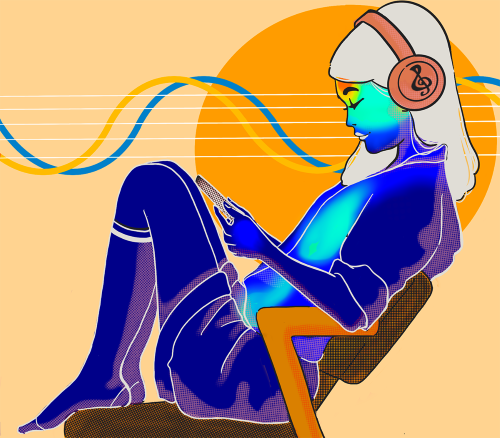Fluctuation of musical chord prediction creates bodily and emotional sensations
“I feel it in my fingers, I feel it in my toes.”
Unlike the lyrics of the classic song by Scottish band Wet Wet Wet, participants didn’t report strong sensations in their limbs, but instead in some of the main organs of the body, notably the brain, heart and abdomen. © 2024 Nicola Burghall/UTokyo
Music which surprises us can be felt in the heart, while music which matches our expectations can bring feelings of calmness and satisfaction, according to a new study. Researchers played eight short tunes made up of just four chords each to over 500 participants. Each tune had a varied mix of surprising and unsurprising, and certain and uncertain chord progressions. When asked to report how the tunes made them feel and where they were affected, participants’ answers showed that fluctuations in predictions about chord sequences were felt in specific parts of the body, notably the heart and abdomen. Researchers also found that sensations in the heart were strongly linked to aesthetic appreciation and feelings of pleasure. These results could have helpful applications for using music to improve well-being.
Whether it’s a breakup ballad, timeless classic or the latest pop hit, music has the power to inspire, connect and deeply move us. And according to a new study at the University of Tokyo and Hiroshima University, it turns out that some tunes really can strike a chord inside us.
“Our research shows that some chord sequences create similar bodily sensations in certain organs, particularly in the brain, heart and abdomen,” said Associate Professor Tatsuya Daikoku from the Graduate School of Information Science and Technology at the University of Tokyo. “This indicates that our interoceptive sense, that is the sensations felt from within the body, may to some degree underlie musical aesthetic appreciation and positive emotion.”

The eight chord sequences. These are the eight chord sequences which were generated using a mathematical model, based on U.S. Billboard songs. © 2024 Daikoku, Tanaka and Yamawaki/ iScience
Based on 890 songs on the U.S. Billboard music charts, the researchers generated eight sequences of four chords which they played to study participants. An important feature of each sequence was the mix of low and high surprise and low and high uncertainty with which the chords progressed. Five hundred and twenty-seven participants listened to the four-chord tunes and indicated on an image where in their body they felt the music and how strongly. They also ranked their top five emotional responses to each sound from a list of options, as well as how much they felt the music appealed to or repulsed them.
By combining these responses, the researchers could create a distinct body map for each sequence of chords. Of the eight sequences, the strongest abdominal sensations were recorded when all four chords progressed with low surprise and low uncertainty, which the researchers called the sLuL-sLuL sequence. This very predictable tune also brought out feelings of calmness, relief, satisfaction, nostalgia and empathy.
Body maps of music sensation. Participants clicked on an image of the body to show where they most felt the music. The more clicks, the stronger the sensation (shown by the blue-low to red-high gradient). Body image “b” shows the sLuL-sHuL sequence (which most affected the heart), while image “a” shows the predictable sLuL-sLuL sequence (which most affected the abdomen). © 2024 Daikoku, Tanaka and Yamawaki/ iScience
The strongest sensations in the heart were felt when the first three chords played with low surprise and low uncertainty, but the final fourth chord elicited high surprise and low uncertainty. This the researchers called the sLuL-sHuL sequence, and the stronger sensations it produced in the heart appeared to be closely linked to stronger feelings of pleasure.
Both the sLuL-sLuL and sLuL-sHuL progressions evoked aesthetic appreciation and reduced negative feelings of anxiety and awkwardness. By contrast, sequences which generated strong sensations in the head were significantly associated with feelings of anxiety and confusion. As this research focused on subjective sensations and emotions, next the team would like to see how more quantifiable physical responses, such as changes in heartbeat, overlay the map of reported sensations.
“Music is not just something we listen to with our ears; it’s an experience felt throughout the entire body. I think this full-body sensation is what truly defines music,” said Daikoku. “This research offers insights into how musical experiences are intricately connected to our bodies. It holds promise for contributing to the use of music in stress relief and enhancing mental health.”
About the study
Journal: iScience*
Title: Bodily Maps of Uncertainty and Surprise in Musical Chord Progression and the Underlying Emotional Response
Authors: Tatsuya Daikoku, Masaki Tanaka & Shigeto Yamawaki
DOI: 10.1016/j.isci.2024.109498
*Rank by Journal Citation Indicator (JCI): Q1
Related links
-UTokyo FOCUS link
*Hiroshima Univesity is reposting this joint press release with the University of Tokyo. Please see the link above for the original.
Related faculty members
Media Contact
Inquiries on the study
Tatsuya Daikoku
Associate Professor, University of Tokyo
E-mail: daikoku.tatsuya * mail.u-tokyo.ac.jp
Shigeto Yamawaki
Professor (Special Appointment), Brain, Mind and KANSEI Sciences Reserch Center
E-mail: yamawaki * hiroshima-u.ac.jp
(Note: Please replace * with @)
Inquiries on the story
Hiroshima University Public Relations Office
E-mail: koho * office.hiroshima-u.ac.jp
(Note: Please replace * with @)

 Home
Home

















